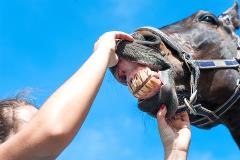Equine Dental Conformation: The Two Most Common Disorders

An assessment to determine the conformation of a young horse should always involve a dental examination of the animal’s bite. This information is important to gather in order to determine if the animal has developmental dental defects that could compromise its growth and development.
Bite Identification of a Young Horse
The bite of a horse is determined by the way that the upper and lower sets of incisors meet at the front of the mouth. The incisors of a horse with a correct bite will meet edge to edge. If the bite is incorrect, the incisors will be misaligned and result in malocclusion. Congenital malocclusions can often be detected in animals within a few weeks after birth.
Two Types of Common Malocclusions
Overjet
The most common type of malocclusion is found when the lower jaw is shorter than the upper jaw. A mild case of top incisor malocclusion is referred to as overjet or overshot, and a severe case is called overbite or parrot mouth. An overjet does not generally develop into an issue that can be detrimental to the animal as long as the malocclusion is restricted to the front teeth.
- Animals with a slight overjet:
- Chewing surfaces of the top incisors are set slightly in front of the chewing surfaces of the lower incisors
- Because the top and bottom incisors are not aligned, the top incisors overhang the bottom
- When an animal’s top incisors grow long, their natural feeding process can be impeded if they are unable to easily grasp food
- Animals with a severe overjet:
- Examination finds all of the top incisors set in front of the lower incisors, which causes the top incisors to grow excessively
- Since the teeth are so far out of alignment, the animal’s bite is not normal, which gets in the way of their natural method of taking in food and decreases their ability to properly chew
- The teeth of animals with a severe overjet bite often form hooks and sharp points causing pain when eating and when taking the bit, requiring more frequent dental examinations
- Treatment of an overjet includes:
- Gradual reduction of the excess tooth growth along the top incisors and cheek teeth
- In animals less than six months of age, the use of wire braces have been used to slow down the growth rate of the upper jaw.
Underjet
An animal with a malocclusion that presents as opposite of an overjet is referred to as having an underjet or undershot jaw. The diagnosis of an animal with an underjet is more commonly found in donkeys than in horses.
- Animals with an underjet:
- Chewing surfaces of the bottom incisors project beyond the top incisors
- The grazing ability of an animal may be difficult because of the inability to nip off the grass.
The main concern for animals diagnosed with either of these malocclusions, overjet or underjet, should focus on the level of involvement of the cheek teeth.
During an examination it is not uncommon to encounter horses that present with abnormalities arising from developmental dental disorders. Identifying the type of abnormality early in an animal’s life will help when presenting client information and in determining if a type of treatment plan is necessary.
Discuss other things to look for during the dental examination of a horse with your Covetrus representative by calling 855.724.3461 today.
Source:
http://www.thehorse.com/articles/28180/developmental-disorders-in-horses


Working Here
Our team members are encouraged to be the best they can be... at Covetrus we believe we impact one another.
Learn MoreNews & Events
FDA Cautions Pet Owners Not to Feed Texas Tripe Inc. Raw Pet Food Due to Salmonella, Listeria Monocytogenes
The U.S. Food and Drug Administration is cautioning pet owners not to feed their pets any of the Texas Tripe brand raw frozen pet food listed below because several samples of Texas Tripe raw pet food have tested positive for Salmonella and/or L. mono.
Careers
Are you looking for a place to let your talents shine? At Covetrus, we help our practitioner customers better serve their patients and take pride in providing the best customer experience possible. Search our open positions to see our available opportunities.
Newsletter
Stay current with what’s going on with Covetrus, subscribe to receive our newsletter and email communications. Subscribers will receive the latest information in practice management, sales and marketing, animal health, and more.



-3-(1).png?sfvrsn=2d806d73_0)

Leave a comment